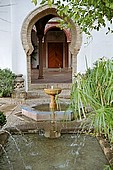Large parts of Spain remained Muslim from the arrival of the Arab armies in 711 to the fall of the emirate of Granada in 1492. The only area of Spain which withstood the invasion was the region of Asturias in the Cantabrian mountains of the north-west.
The flourishing multi-cultured society of these centuries has created a treasury of palaces and religious buildings of the finest artistic value.
At a time when London was a tiny village, in Cordova under the Umayyad Dynasty there were half a million inhabitants, 700 mosques and 300 public baths. The streets were paved and lit. The houses had marble balconies mosaic floors adorned with gardens with fountains and orchards.
The classic culture that remained obscured and lost to Christian Europe during long centuries of barbaric domination of western Europe managed to survive and to be transmitted thanks to the Islamic intellectual community, that kept the original Greek culture from eastern Europe and brought it in Islamic Spain.
Andalusia, Moorish architecture |

|
The centuries of domination of Muslims, or Moors as the Spaniards call the Muslims, created a treasury of palaces and religious buildings of the finest artistic value that still survive
today in the architecture of Spain. A tour of southern Spain is unique in a European setting. It offers a sight into a great past.
The most numerous buildings surviving from the Islamic period in Spain are mosques, palaces, castles and fortifications, churches, villages and towns which can be found throughout the country.
After the re-conquest most of the mosques of Spain were converted into churches, some with very little alteration
but in others the architecture was profoundly damaged as in the case of the Great Mosque of Cordoba where a cathedral was built in the middle of the structure in the sixteenth century.
In addition to specific buildings and monuments many towns and villages retain the layout and appearance of Islamic times. Some of the more important cities with substantial traces of Islamic architecture are Cordoba, Seville. Granada.
Again some of the finest examples of Islamic palaces can be found in Spain such as the Alhambra and the Generalife at Granada.
Characteristic features of Spanish mosques are square minarets and large mihrabs which are sometimes like a separate room. Where decoration has survived intact it is usually very elaborate and includes carved plaster and woodwork.
Notable features of Spanish Islamic architecture include horseshoe arches, paired windows with a central column, construction in brick and stone, polychrome tiles, intricate carved stucco work and overlapping arches.
The influences of Islamic buildings in Spain come from North Africa and Syria. The North African influence is easy to explain through its proximity and the successive invasions of Berber tribes, the most famous example being the Giralda tower in Seville and in Marrakesh and Rabat.
To describe Islamic-type architecture in Spain the best-known term is 'Moorish' which is often used to refer to Islamic architecture in general although it more properly should be used to describe the architecture of the Moors or Berbers of North Africa.
The less well-known term Mudejar refers to architecture carried out for Christian patrons by Muslim craftsmen. Mudejar architecture uses many of the most characteristic features of Islamic architecture including Arabic calligraphy and the horseshoe arch.
Many of Christian Spain's most beautiful churches and palaces were built by Mudejar craftsmen and the tradition was carried on into the new world.
A related style is known as Mozarabic which refers to the architecture of Christian and Jewish buildings under Muslim rule.
Andalusia, Spain |

|
The first period in Moorish Spain architecture goes from the first Umayyad Governors in 711 a.d. to the Umayyad Caliphate 1031 a.d. The Umayyads merged elements of Hispano-Roman and Visigothic architecture with the Islamic ideas of plan and decoration. The hallmark of this period is the construction of the Great Mosque of Cordoba.
During the following Almoravid and Almohad Rules (1088-1232) art and architecture were drawn across the Strait of Gibraltar, as artisans from the peninsula worked in Marrakesh and Fez. Architecture took on a new conservatism in plan and a decorative simplicity. The minaret called La Giralda of the Great Mosque of Sevilla (now
destroyed) is an example of Almohad style.
Spain, Granada: the Alhambra
|
 |
During Nasrid Kingdoms (1238-1492) arts grew and displayed far more variety and richness. The finest decoration arts that survive from al-Andalus are from this period. The Alhambra, the last major Islamic monument of Spain, was their greatest work.
|
Related Pages
††-
††-
††-
|
|



